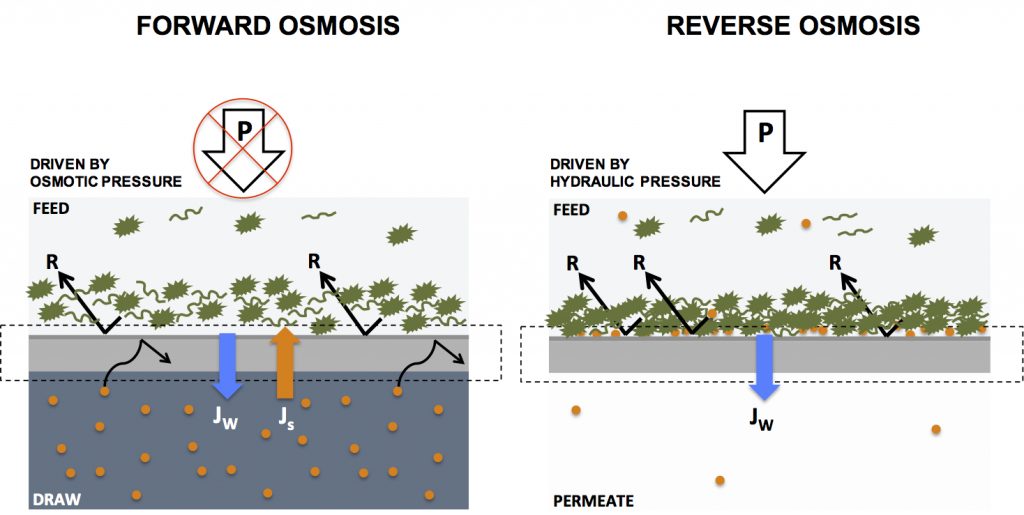- Forward osmosis is not dead – interview with leading water consultant Walid Khoury - August 30, 2020
- Listing of major commercial & academic FO players on ForwardOsmosisTech - April 12, 2020
- 0.26MGD FO-SWRO Hybrid for seawater desalination achieves 25% energy reduction compared to MF/SWRO - December 14, 2019
The shortest possible explanation of water filtration, forward osmosis, and reverse osmosis – here’s our attempt
Membrane based water filtration systems and processes require energy to extract clean water from impaired water sources. Electrical energy is needed for traditional hydraulic pressure driven processes such as reverse osmosis, nano-filtration, ultra-filtration, and micro-filtration whereas chemical energy is utilized in forward osmosis processes.
In reverse osmosis water filtration, a hydraulic pressure drives water transport across a semi-permeable membrane against the osmotic pressure gradient between feed (impaired water source with high solute concentration = high osmotic pressure) and permeate (purified water with low solute concentration = low osmotic pressure) streams. The output of reverse osmosis water filtration is purified water (the permeate) and a concentrated impaired water source (the retentate or RO brine).
In forward osmosis water filtration, an osmotic pressure drives water transport across a semi-permeable membrane along the osmotic pressure gradient between feed (impaired water source with low solute concentration = low osmotic pressure) and draw (engineered solution with high solute concentration = high osmotic pressure) streams. The output of forward osmosis water filtration is a draw stream diluted with purified water (the permeate) and a concentrated feed stream.
This fundamental difference in energy requirement means that forward osmosis processes require up to 90% less energy than reverse osmosis processes to drive water transport. However, the output of forward osmosis and reverse osmosis water filtration processes are also fundamentally different.


Has a 3 layer membrane been tried? Top and bottom layer with traditional FO membrane with the center layer being a ultra filtration hollow fiber to quickly and easily remove the fresh water?
Hi Joseph,
Apologies for the late reply and thanks for reaching out. I believe a hollow fiber membrane with FO rejection layer on both the shell and lumen side isn’t a viable solution in praxis due to internal concentration polarization in the center layer.
I did a quick literature search and couldn’t find any articles on your idea either.
Cheers
Mark
Have you done any work on combining FO with green hydrogen production? This article caught my eye: https://www.chemistryworld.com/news/seawater-splitting-system-could-scale-up-renewable-hydrogen-production/4013332.article